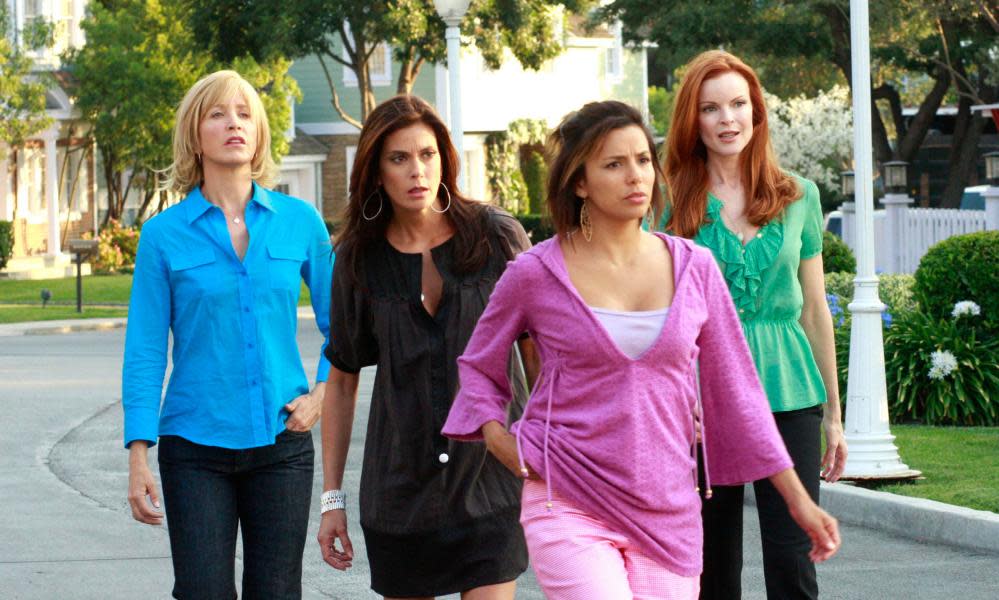Desperate Housewives: soapy, superbly acted and still fun, nearly 20 years on

Somewhere between Riverdale and Days of Our Lives, Desperate Housewives reminds us that seemingly happy homemakers can be one transgression away from utter destruction
Desperate Housewives is streaming on Disney+ in Australia. For more recommendations of what to stream in Australia, click here
As the Sex and the City finale aired in 2004, another television fantasy of female friendship dreamed up by a gay man was just beginning. But where Carrie and her BFFs live a “you go girl” life of cosmopolitans and Manolos, Marc Cherry’s Desperate Housewives inhabit the decidedly darker universe of Wisteria Lane. Susan Mayer (Teri Hatcher) is a single mum with the fittingly quaint profession of children’s book illustrator. Her neighbours Bree Van de Kamp (Marcia Cross), Gabrielle Solis (Eva Longoria) and Lynette Scavo (Felicity Huffman) are homemakers. They’re also financially dependent on their husbands, so are forced to exert power in subversive and sometimes downright violent ways. Cherry was inspired to create the show after watching a news report on Andrea Yates, a Texan housewife who drowned her five kids in a bathtub while suffering from postpartum psychosis.
While Desperate Housewives immediately drew large audiences, critics were unsure how to categorise it. Was it a drama, mystery, comedy or merely a trashy soap? Speaking to Vanity Fair in 2005, Hatcher and James Denton, who plays Susan’s partner Mike, rejected the soap opera label, for its association with “bad lighting, bad writing, [and] bad acting”. To the contrary, Desperate Housewives is superbly acted, slickly produced and packed with delightfully acerbic lines. Yet, it’s the show’s highly stylised theatricality – its “soapy” elements – that both drew me to it as a teenager and make it so enduringly fun nearly two decades on.
The plot is by no means believable: the first season alone sees suicide, infanticide, murder, blackmail and not one, but two house fires. But no one watches narrative television for the humdrum of real life! We watch for the theatre of Gabrielle mowing the lawn in a ball gown and stilettos in the dead of the night, so her husband doesn’t find out she’s sleeping with their teenage gardener. And for the macabre hijinks of town busybody Mrs Huber, who is so jealous of her perfect neighbour Bree’s lawn that, when a jogger collapses outside her house, she dumps the body on Bree’s hydrangeas rather than call 911.
Related: Still Life: 2013’s big-hearted gem is a salute to all the lonely people
The show’s success proved that a fantastical spin on the lives of housewives – albeit unreasonably hot ones – was meaty and compelling enough to sustain a primetime audience’s attention. Beneath its fairy floss exterior, Desperate Housewives explores the deep sadness, thwarted hopes and simmering rage that often afflicts women confined to the domestic sphere. Season one begins with the death of Mary Alice Young who, despite her “perfect life”, felt compelled to blow her brains out with a pistol one pleasant afternoon. While Bree, Gabrielle, Lynette and Susan are shocked and confused by her death, they all understand her desperation more than they let on. In one memorable scene, Lynette, who is overwhelmed by her children and coming down hard from the ADD medication she’s been stealing from them, suddenly sees her dead friend bathed in a halo of white light. Looking calm and peaceful, Mary Alice hands over the pistol she used to kill herself and smiles encouragingly as Lynette guides it to her own head, to the sound of Simon and Garfunkel’s Feelin’ Groovy. This grim scene is one of Desperate Housewives’ many allusions to the fragile and tenuous nature of family life.
Clocking eight seasons, Desperate Housewives is still the longest running hour-long scripted series with all-female leads. The tentacles of its legacy are far-reaching, as it inspired the behemoth Real Housewives reality franchise. In the opening credits of The Real Housewives of Orange County, which premiered in 2006, the women hold oranges in their hands, an homage to the biblical apples featured in the credits of Desperate Housewives. Both shows use glamour and wealth as a Trojan horse to offer a complex, moving exploration of the many joys and humiliations of middle-aged womanhood. But while betrayal, infidelity and financial ruin are par for the course on Real Housewives, reality is yet to deliver the murderous twists and turns of Wisteria Lane.


